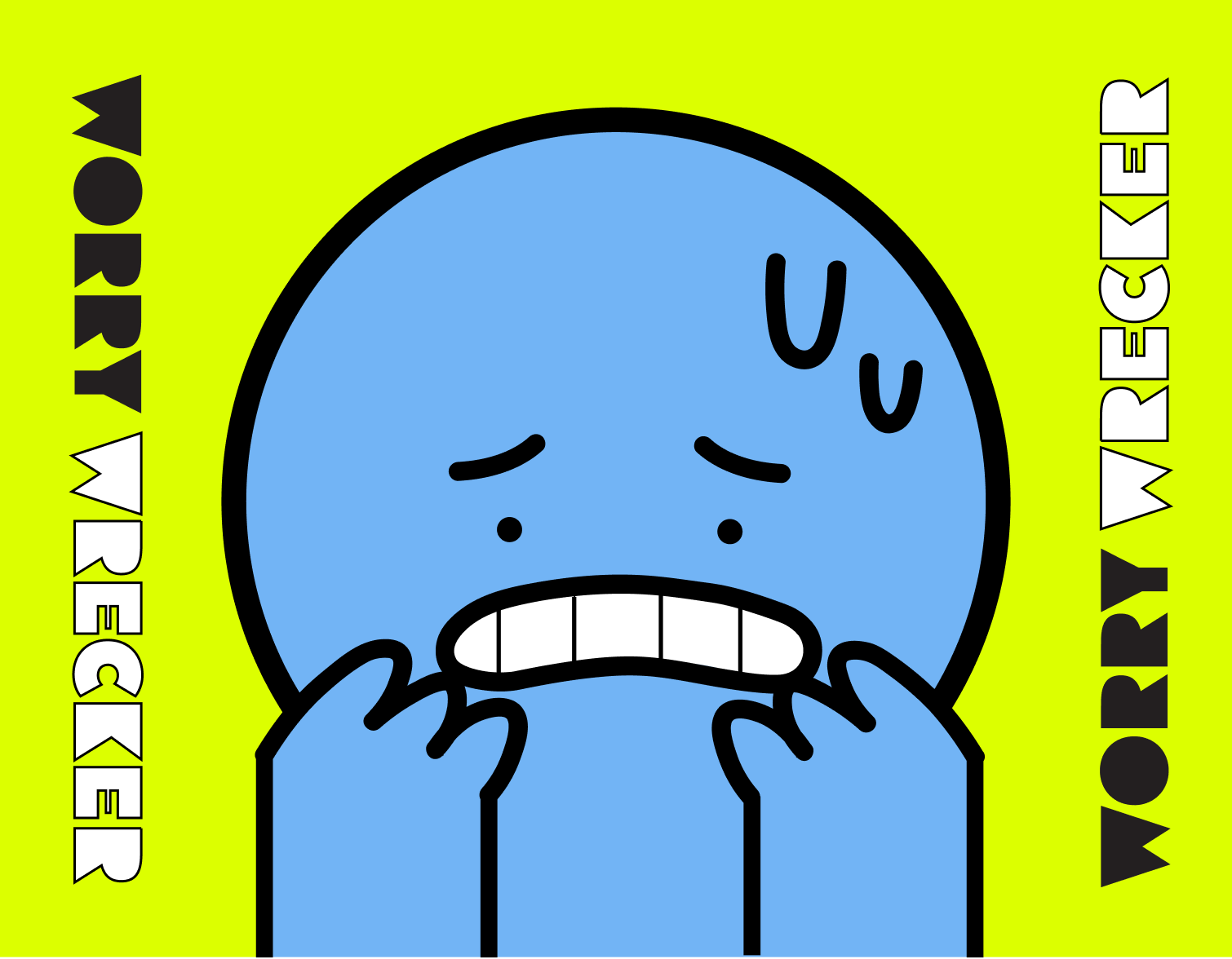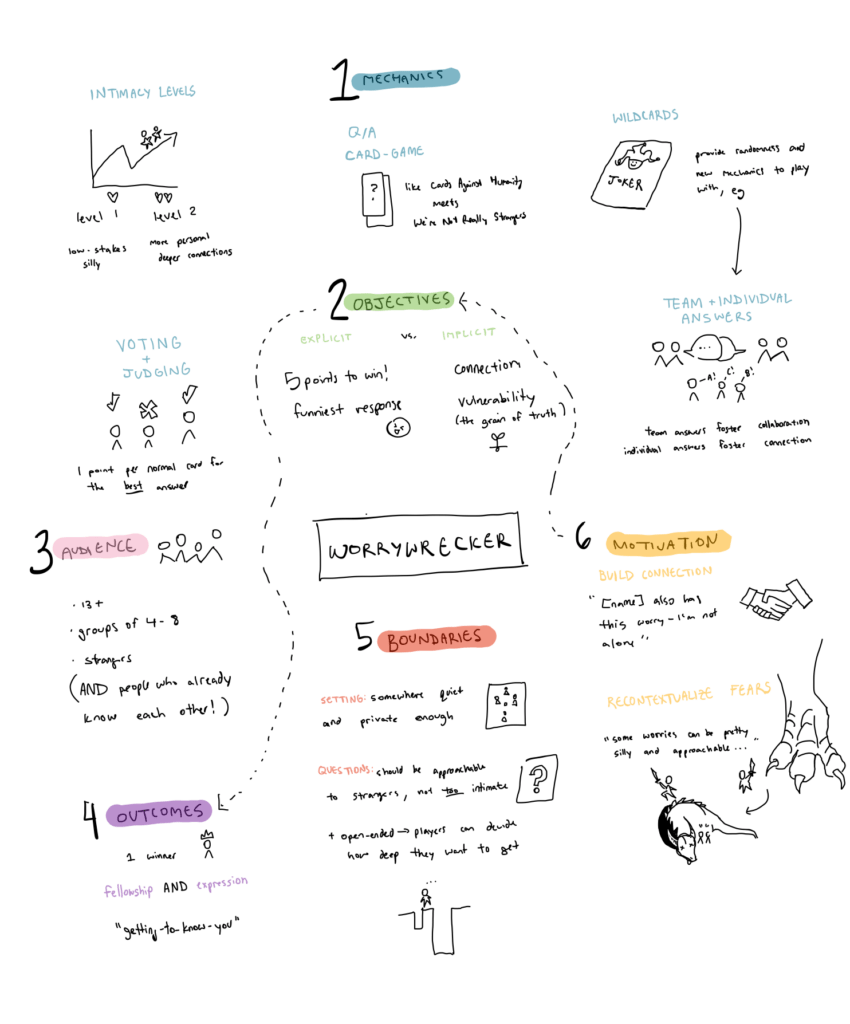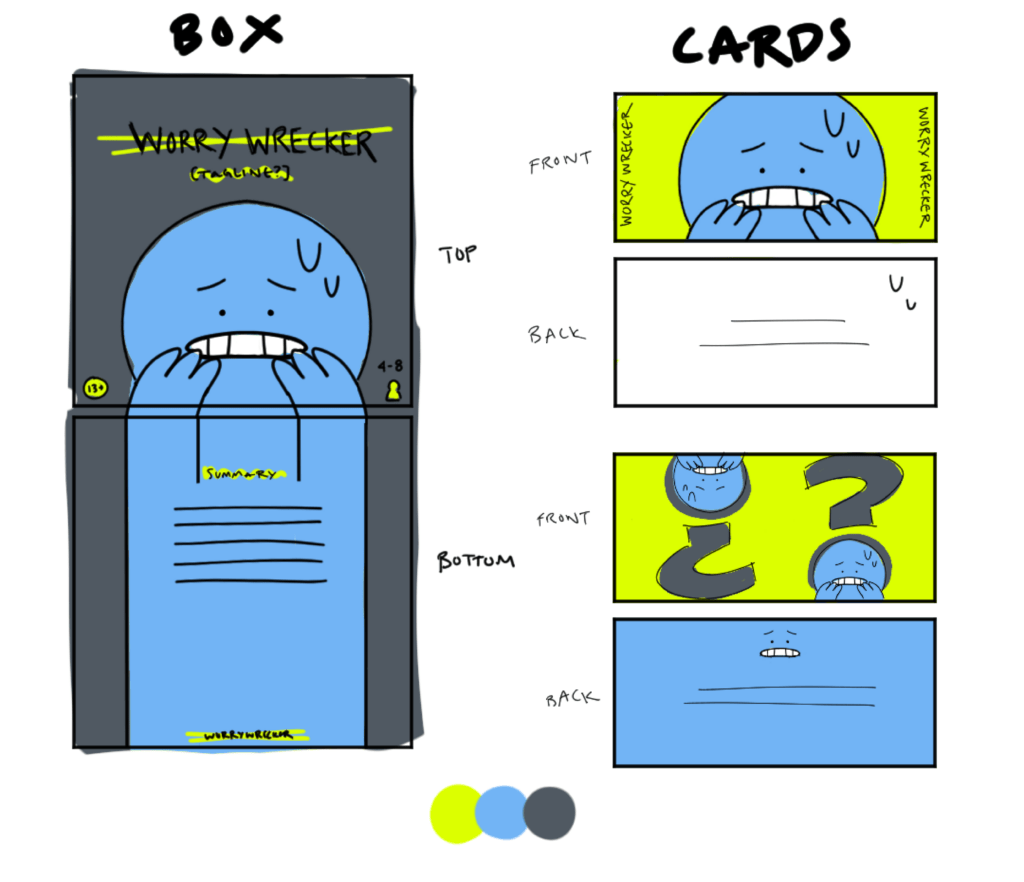Artist’s Statement
Worry Wrecker is an opportunity to invite others into your circle of trust through shared laughter, story-telling, problem-solving, and friendly competition. Each card is designed to prompt a revelation– a worry, a response to a hypothetical situation, a confession, perhaps? Be rewarded for making a genuine effort to establish new friendships, strengthen existing ones, or take things “to the next level”. Allow vulnerability to become your superpower.
There is never a dull moment as players fill the airwaves with stories about their adventures navigating our complex world and its myriad qualms. Wildcards are shuffled alongside the main deck, introducing a level of uncertainty to the trajectory of the game, reflecting the unpredictable journey of the human experience. You are not alone.
Do you intend on playing with “strangers”? You’ll soon find that the term “stranger” is misleading in that oftentimes there is nothing “strange” about them as you quickly find commonalities in the most unexpected of situations. Start off with the level 1 deck to help establish a low-stakes environment for genuine human connection (…with a good amount of silliness in there for good measure). If you’re feeling comfortable, “go to the next level” with level 2 which ups the stakes for those willing to take the plunge into the deep waters of authenticity, respect, and imagination.
Players may choose to switch levels at any time. However, for new players, we recommend completing at least 1 complete round of level 1 before continuing to level 2 to get a feel for the social atmosphere and types of questions involved.
Wreck your worries before they wreck you.
Concept Map
Our concept map for Worry Wrecker. We paid special attention to the types of fun we wanted to evoke for the players.
Design Iteration
Worry Wrecker took a lot of initial inspiration for its formal elements and main gameplay mechanics from We’re Not Really Strangers, another card game that focuses on open-ended responses from players as opposed to highly structured, win-focused games. After playing the game, we all really appreciated the more conversational format and intimate atmosphere created through the group dynamics. We wanted to leverage this feeling with a specific emphasis on players’ worries, a sometimes emotionally challenging topic that everyone has experience with. Our goal was to create and work on a game that could be fun and cathartic like We’re Not Really Strangers but also genuinely helpful as a way to relieve people of their struggles emotionally, even if only for a little while.
To this end, we really wanted to value certain types of fun and formats of play to best achieve our goal. Early in the design process, we decided to highlight the aesthetics of fellowship, discovery, and expression as the main avenues of fun for players. While we imagined some players could find enjoyment more in the unveiling of other people’s thoughts and traits that they might not have known about prior to playing, others still might find the game a great way to vent some of their daily frustrations in a healthy and fun manner.
Formal Elements
For this kind of game, we determined that it would be best enjoyed by its players if there were enough people to facilitate interesting and varied responses to questions. At the same time, we needed a limit such that finishing a round wouldn’t become unmanageable or take longer than approximately 30 minutes. Roughly 4-8 people is an ideal size to suit this goal while still allowing for an intimate atmosphere where players feel comfortable enough to share. We imagine Worry Wrecker as being played between close friends or acquaintances, with people who are not particularly close playing the Strangers edition of the game.
The objective of the game is to learn more about your fellow players and grow closer together. Outcomes are determined by the number of points each player has at the end of the game, with the “win” state defined as when any player collects 5 points.
The original rules, procedures, and resources of the game were all aimed towards creating a comfortable and non-competitive atmosphere for the players. At first, we didn’t want to incorporate a point system. We felt that it would draw away from the main focus of human connection by assigning point values to player moments of vulnerability. However, later playtests showed us this was not the case. For more detailed information on these formal elements, see the following section on playtests and feedback.
Finally, boundaries were an essential part of developing the game from the very beginning. We were cognizant of the intimacy curve discussed in class and made sure to build a game environment where players felt comfortable and safe enough to reveal their own worries, insecurities, or doubts with other players. As with the rules and procedures, our approach to these key considerations changed over time throughout the iterations of our design.
Playtests and Feedback
To test Worry Wrecker, we ran three separate playtest sessions during class. Each session consisted of randomly selected students, the majority of whom had never met each other before.
First Playtest
Our first iteration of rules involved players drawing cards one at a time from a pile of questions. They would answer the question on the card, and the other players would brainstorm together to find a solution to the problem or worry.
However, we were quite surprised by the feedback we received from this session. Although we had tried to be careful of creating a gradual increase in intimacy, players found they had no frame of reference for the jump in vulnerability from level 1 to level 2. Some questions also seemed to be miscategorized, with levels of intimacy that might be expected for a level 2 question present on a level 1 card. This left players with less trust in the level system and a heightened sense of anxiety about what the next card would be. Further, the first person in a round to draw a card felt the pressure of setting a precedent, as their response would set the tone and level of intimacy expected for the rest of the group. If a player decided to play a card more earnestly, other players might feel uncomfortable matching their vulnerability but be forced to due to social pressure.
To reduce these pressures, we removed the levels system entirely and instead organized the cards by their “theme”, with a new option to allow players to roll a die and randomly choose between two themes. Doing this allowed players to select the theme they were more comfortable talking about. During the last playtest, we were told that the level rating had highly influenced the framing of the question itself, so we used “themes” to remove that external structure and the pressure to talk about something too vulnerable, hopefully producing a more appropriate intimacy scaling mechanism. To address the issue of precedence setting, we switched from spoken responses to written responses, with everyone drawing their cards for the round at the same time and writing their responses independently. This way, no one could influence another player’s response. After two minutes of writing time, players would come back together and share out loud around the group before starting the problem-solving session.
Second Playtest
From the second playtest, we received insightful and important critiques on the “solution” focus of our game thus far and the best format for players to interact with each other. While we had been hopeful about the potential for themes to give players more agency over what topics to discuss, we found that even with this adjustment, players still felt that questions became way too vulnerable way too quickly. In the first round, for example, one player randomly received a question that was much more vulnerable than the other two players, creating an uneven dynamic of exposure that was commented on. Players also brought up points against the mechanic of “solving” a fellow player’s worry. As the questions were frequently vulnerable, they touched on topics players had likely been dealing with for prolonged periods of time, and they felt awkward as they tried to quickly solve deep dilemmas with necessarily shallow responses. We took this feedback to heart; although we had hoped this mechanic would allow for greater connection, we understood the feedback to be valid and moved away from this objective in future iterations. Another point was made in opposition to written responses, with some players saying it felt like there was too long of a silent gap in gameplay for a game that is primarily about socializing. We took this into account and changed back to spoken responses in the next iteration.
Interestingly, we received feedback that having levels for the questions, as we had implemented in our initial iteration, would be better. This was the beginning of an ongoing trend in our playtesting experience, where features and changes we made in direct response to previous feedback would be requested to be reverted during the next iteration. While this made progress confusing and difficult at times, it gave us the opportunity to learn to read between the lines of user observations to determine the true friction with the game and adjust accordingly.
Overall, we gathered from this playtest that our initial demographic of both close friends and acquaintances answering the same questions had its own pitfalls. In preparation for our next iteration and final playtest, we decided to focus on a “Strangers” pack version of the game, intended for people who were not familiar with one another. This pack would feature the funny or less vulnerable questions that had been successful in former playtests, while the main version of the game would include the more intimate questions. This would also, we hoped, alleviate the stress of playing in the classroom playtest setting, where being paired randomly with other students did not suit the intended atmosphere of the main game. We also introduced wildcards to the pack, which would change the mechanics for one turn and allow for different types of gameplay to break up the monotony. Finally, we added a point mechanic to end the game after one player wins 5 points.
Final Playtest
Our final playtest video can be found here.
For the final playtest, we distributed the rules on a sheet of paper for playtesters to review without moderator intervention. From the feedback given afterward, this method worked fine and the ruleset was clear enough. All participants said they could play again without rereading the rules.
Overall, players reacted positively to many of the changes we made, including the inclusion of more funny, conversation-starting questions instead of more vulnerable ones. Most players said they weren’t even intending to win while playing, instead focusing on making entertaining answers and engaging with their fellow players. This felt successful to one of our fundamental goals, which was to emphasize connection over competition. However, more finessing of the intimacy level of the questions was required, as the players unluckily drew one of the more intimate questions first, resulting in a first-round that flowed less freely than those following it. Players also seemed to enjoy the wildcard aspect, though they again unluckily didn’t get a chance to test them thoroughly during their time with the game.
Once again we received conflicting feedback, with some players suggesting that writing responses would be better than speaking them out loud. At this point in our design, we took this as a sign that perhaps players were somewhat uncomfortable with some of our questions. Therefore, we decided to work on adjusting the vulnerability level of the cards rather than changing this mechanic again.
Final Prototype
Design and Marketing Presentation
Pictured above are the original concept drawings for Worry Wrecker. On the left is the front and back card design, with the right image showing the original box and wildcard designs.
For the final box design and art direction, we decided to go for a cartoonish look with bold, solid colors. We wanted our design to pop and stand out to potential players, and we felt the very cartoonish, emotive design lent a modern and illustrative feel. The colors themselves aren’t commonly used, especially together, and we thought the unconscious surprise felt upon seeing it lent to the feeling we were hoping to evoke with the game: slight discomfort, to get people out of their comfort zones and open up. We tested the colors for accessibility for colorblind people as well to ensure maximum contrast and readability.
The Figma design document can be found here.
The final print and play can be found here.
Final Ruleset and Conclusion
Our final rule set builds on the mechanics of our last playtest and the critiques from its participants. To add more progression, we expanded the Strangers pack to include two levels and more wildcard options for each level, allowing players even more control over the intimacy of the game. We also moved to a new format to encourage more conversation, with every player responding to every question card instead of just one at a time. We thought this would spark more engagement throughout the whole game, keeping the conversation flowing and allowing connections to be made.
Looking back on our initial goals for Worry Wrecker, we believe that through the iteration process, we were able to end up with a final product that more closely aligns with our original goals. Although our final Strangers pack edition involves less soul-baring questions, we think that it better addresses the real objective: bringing people closer together and allowing them to move past their worries, even if for a moment. By making the game more classically enjoyable we can still further our goals for fellowship, discovery, and expression aesthetics without the friction of difficult conversations with strangers.






